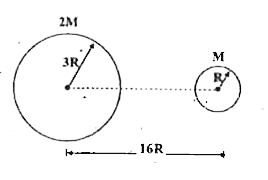Two spherical bodies of masses and and radii and respectively are held at a distance from each other in free space. When they are released they start approaching each other due to the gravitational force of attraction , then find
the ratio of their accelerations during their motion
their velocitites at the time of impact.

Taking both the bodies as a system, from conserving momentum of the system
again , if the accelerations are and , the net external force on the system
Now conserving the total mechanical energy, we have
,
Note : The velocities and accelerations are w.r.t. the inertial reference frame (i.e. the centre of mass of the system).

Similar Questions
Two spherical bodies of masses m and 5m and radii R and 2R respectively, are released in free space with initial separation between their centres equal to 12 R. If they attract each other due to gravitational force only, the distance covered by smaller sphere just before collision is
View SolutionTwo spherical bodies of masses m and 6m and radii R and 2R respectively are released in free space with initial separation between their centres equal to 10 R . If they attract each other due to gravitational force only , then the distance covered by smaller sphere just before collisions will be
View Solution
Knowledge Check
Two spheres of masses 2 M and M are intially at rest at a distance R apart. Due to mutual force of attraction, they approach each other. When they are at separation R/2, the acceleration of the centre of mass of sphere would be
A0m/s2Bgm/s2C3gm/s2D12gm/s2
Two spherical bodies of mass M and 5M & radii R & 2R respectively are released in free space with initial separation between their centres equal to 12R. If they attract each other due to gravitational force only, then the distance covered by the smallar body just before collision is
View SolutionTwo particles A and B of mass 1 kg and 4 kg respectively approach each other due to their mutual gravitational force only. Then the ratio of acceleration of A to B at any instant is
View SolutionTwo point charges, each of mass m and charge q are released when they are at a distance d from each other. What is the speed of each charged particle when they are at a distance 2r ?
View SolutionTwo planets of masses M and M2 have radii R and R2 respectively. If ratio of escape velocities from their surfaces v1v2 is n4 , then find n :
View SolutionWrite an expression for the gravitational force of attraction between two bodies of masses m1 and m2 separated by a distance r .
View SolutionFour particles, each of mass M and equidistant from each other, move along a circle of radius R under the action of their mutual gravitational attraction. The speed of each particle is:
View SolutionFour particles, each of mass M and equidistant from each other, move along a circle of radius R under the action of their mutual gravitational attraction. The speed of each particle is:
View Solution
